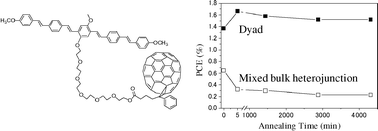Morphological stability of organic solar cells based upon an oligo(p-phenylenevinylene)–C70 dyad†
Abstract
An oligo(p-phenylenevinylene)–C70 dyad achieves the highest power conversion efficiency (1.92%) in dyad-based organic solar cells to date. Covalent attachment in the dyad prevents large phase separation, resulting in good morphological and device stability at high temperatures as compared with mixed bulk heterojunction devices.


 Please wait while we load your content...
Please wait while we load your content...